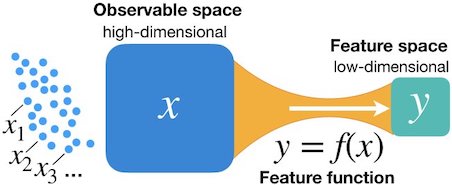This repository shows how to implement the Renormalized Mutual Information described in the paper "Renormalized Mutual Information for Artificial Scientific Discovery" by Leopoldo Sarra, Andrea Aiello and Florian Marquardt.
Renormalized Mutual Information is a quantity that allows to quantify the dependence between a given random variable and a deterministic function of it. In addition, it can also be used to extract a low-dimensional feature of a high-dimensional system by maximizing the renormalized mutual information that the feature has with the system.
Usual Mutual Information can't be used in this context, because it would always diverge for any choice of the feature. This is due to the deterministic dependence of the feature with the high dimensional variable. The mere addition of noise to mutual information to regularize the divergence is not enough to solve the problem: there is no guarantee that the optimal feature is not affected by the noise.
That's the reason why Renormalized Mutual Information should be used in the context of deterministic and continuous functions of random variables. Please refer to the paper for more information.
Here, we show how to implement the estimation and optimization of Renormalized Mutual Information in the case of low-dimensional features. This case is easier to handle because the entropy of the feature can be estimated efficiently with a histogram.
Please have a look at the quick start notebook for a self-contained introduction to Renormalized Mutual Information!
- git clone this repository
- install the requirements
numpy, scipy, tensorflow, matplotlib, tqdm- for example, just run from the code folder:
pip install -r requirements.txt
- for example, just run from the code folder:
- explore the example notebooks
- try new applications!
For further information, have a look at the documentation.
The class rmi.estimation can be directly used to estimate renormalized mutual information, for features that you provide (i.e. expressions f(x) of the high-dimensional variables x).
To estimate renormalized mutual information, the general workflow is:
import rmi.estimation as infsamples = ...generate samples, shape[N_samples, dim_x]- define a feature function, that should return the feature with shape
[N_samples, dim_feature]and its gradient with shape[N_samples, dim_feature, dim_x] feature, grad = feature_func(samples)inf.RenormalizedMutualInformation(feature, grad)returns Renormalized Mutual Information
Please refer to the notebooks for some comments and usage examples.
Feature extraction is about automatically finding the optimal feature for a given distribution of high-dimensional data x. It is implemented in TensorFlow in the class rmi.nn.
To apply neural network feature extraction:
import rmi.neuralnets as nn- define the neural network through a custom Keras model
rmi_optimizer = nn.RMIOptimizer( layers=[ nn.K.layers.Dense(30, activation="relu",input_shape=(2,)), nn.K.layers.Dense(1) ]) rmi_optimizer.compile(optimizer=nn.tf.optimizers.Adam(1e-3))compile the modelrmi_net = nn.Net(rmi_optimizer)define an object that helps to handle the training through Renormalized Mutual Information maximization- define a
get_batchfunction that takes no arguments and returns a batch of samples rmi_net.fit_generator(get_batch, N_train)to train the model forN_trainsteps
One can evaluate the output of the network as rmi_net(samples), or get both feature and gradient through rmi_net.get_feature_and_grad(samples).
Please refer to the provided notebooks for examples.
If you find this code useful in your work, please cite our article "Renormalized Mutual Information for Artificial Scientific Discovery", Leopoldo Sarra, Andrea Aiello, Florian Marquardt, arXiv:2005.01912
available on
https://arxiv.org/abs/2005.01912
This work is licensed under a MIT License.


